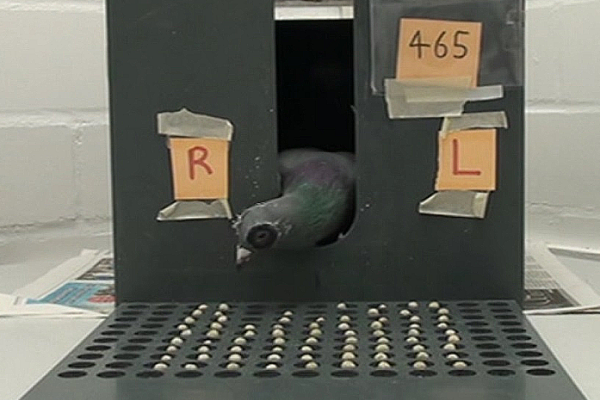2017-11-14

It is still an unanswered question how genetic and environmental factors interact to establish a lateralized brain. In pigeons, the left-hemispheric dominance for visuomotor control depends on asymmetrical light stimulation during embryonic development. In the current study, we explored in how far dominances of the right brain side are determined in parallel. A typical right-hemispheric specialization is visuospatial attention as indicated by enhanced attention to the left visual field. This attentional bias can be demonstrated in a food cancellation task where pigeons have to peck grains regularly scattered on an area in front of them. Comparing the pecking pattern of pigeons with and without embryonic light experience shows that light-exposed pigeons displayed a preference to peck into the left hemifield, supporting a right hemispheric dominance for visuospatial attention. Light-deprived birds on the other hand, displayed an attentional bias to the right halfspace. Thus, light incubation does not simply induce an asymmetry of visuospatial asymmetry; an already present right hemifield bias is rather shifted towards the contralateral left hemifield by asymmetrical light incubation. Moreover, light-exposed pigeons displayed enlarged attentional visual fields extending into the contralateral visual halfspace with each eye compared. These data indicate that asymmetrical embryonic light experience modifies processes regulating biased visuospatial attention and hence, support the impact of light onto the emergence of functional dominances in both brain sides.

It is still an unanswered question how genetic and environmental factors interact to establish a lateralized brain. In pigeons, the left-hemispheric dominance for visuomotor control depends on asymmetrical light stimulation during embryonic development. In the current study, we explored in how far dominances of the right brain side are determined in parallel. A typical right-hemispheric specialization is visuospatial attention as indicated by enhanced attention to the left visual field. This attentional bias can be demonstrated in a food cancellation task where pigeons have to peck grains regularly scattered on an area in front of them. Comparing the pecking pattern of pigeons with and without embryonic light experience shows that light-exposed pigeons displayed a preference to peck into the left hemifield, supporting a right hemispheric dominance for visuospatial attention. Light-deprived birds on the other hand, displayed an attentional bias to the right halfspace. Thus, light incubation does not simply induce an asymmetry of visuospatial asymmetry; an already present right hemifield bias is rather shifted towards the contralateral left hemifield by asymmetrical light incubation. Moreover, light-exposed pigeons displayed enlarged attentional visual fields extending into the contralateral visual halfspace with each eye compared. These data indicate that asymmetrical embryonic light experience modifies processes regulating biased visuospatial attention and hence, support the impact of light onto the emergence of functional dominances in both brain sides.